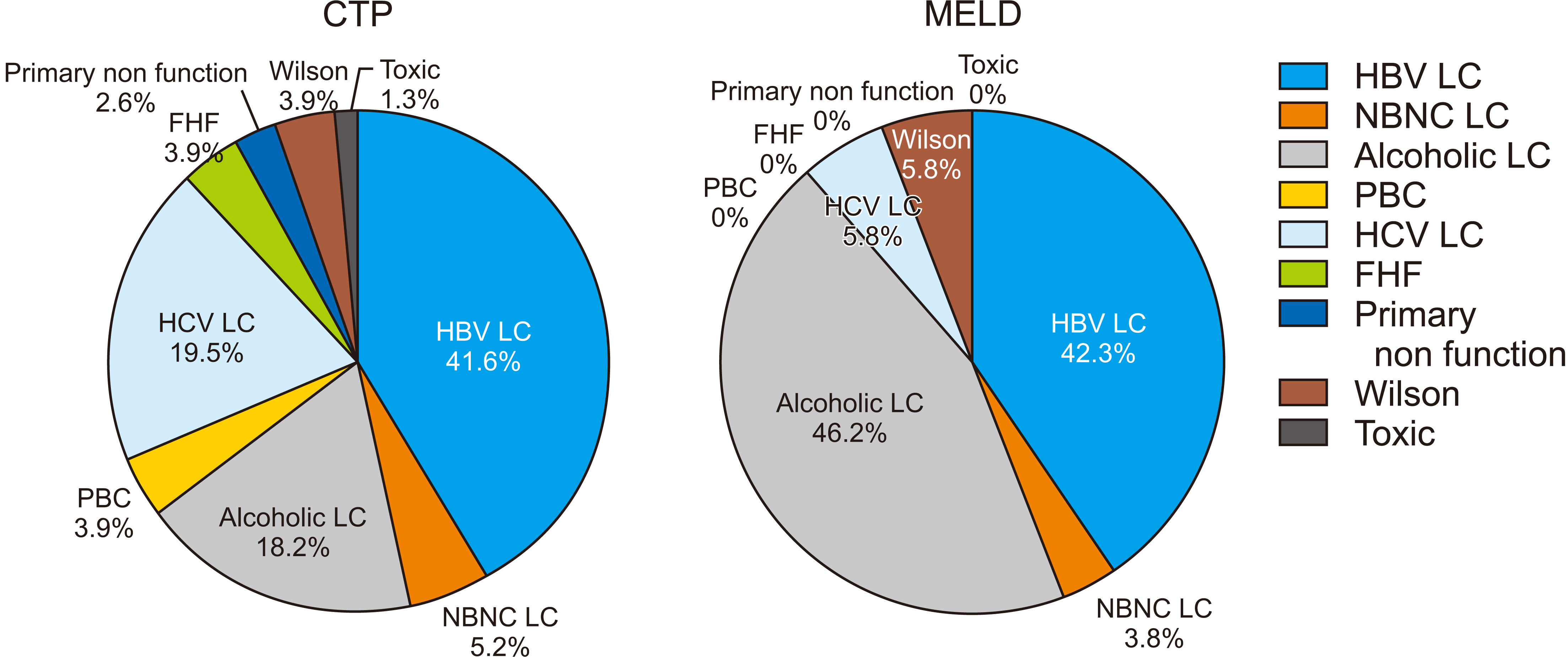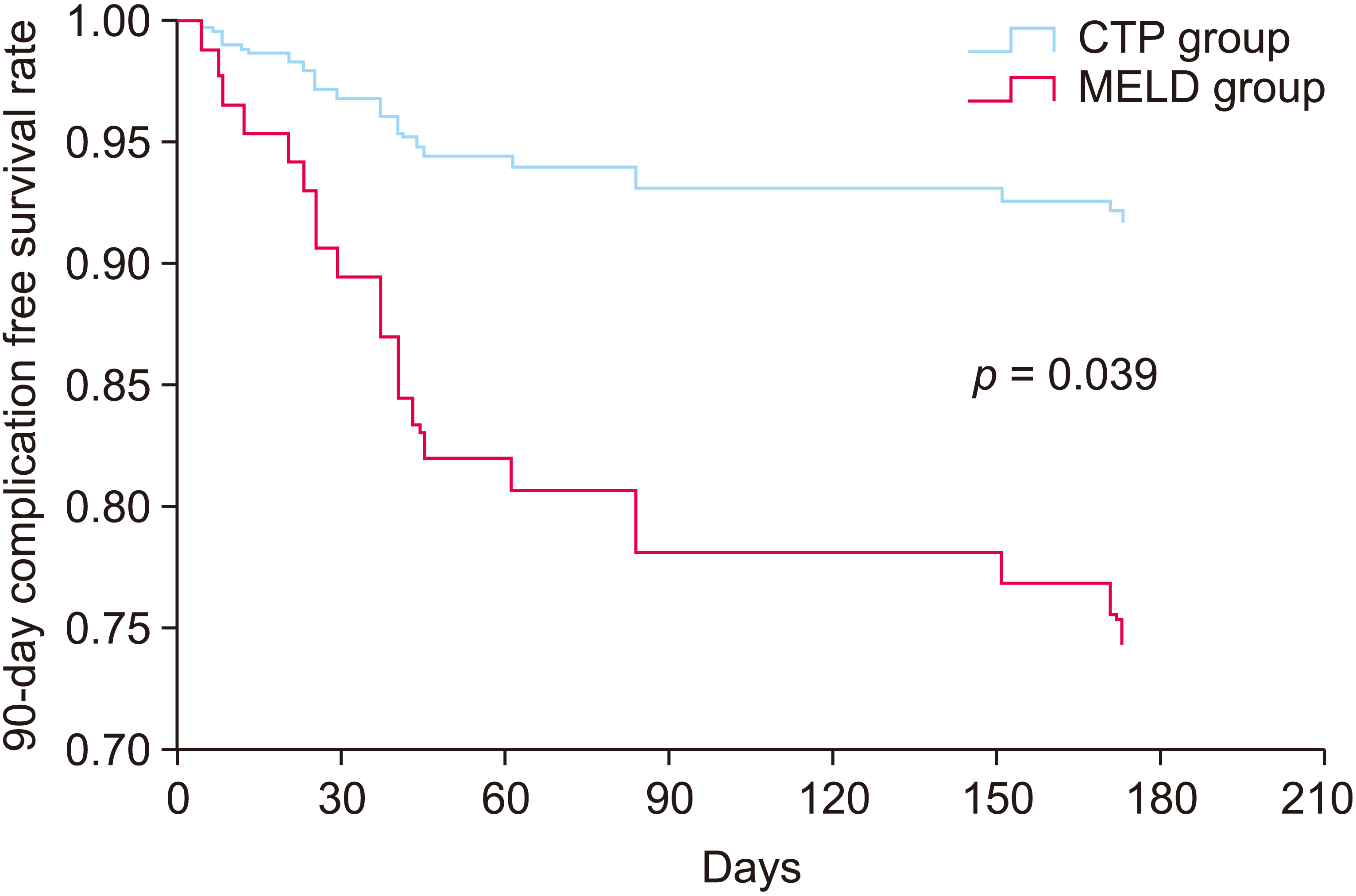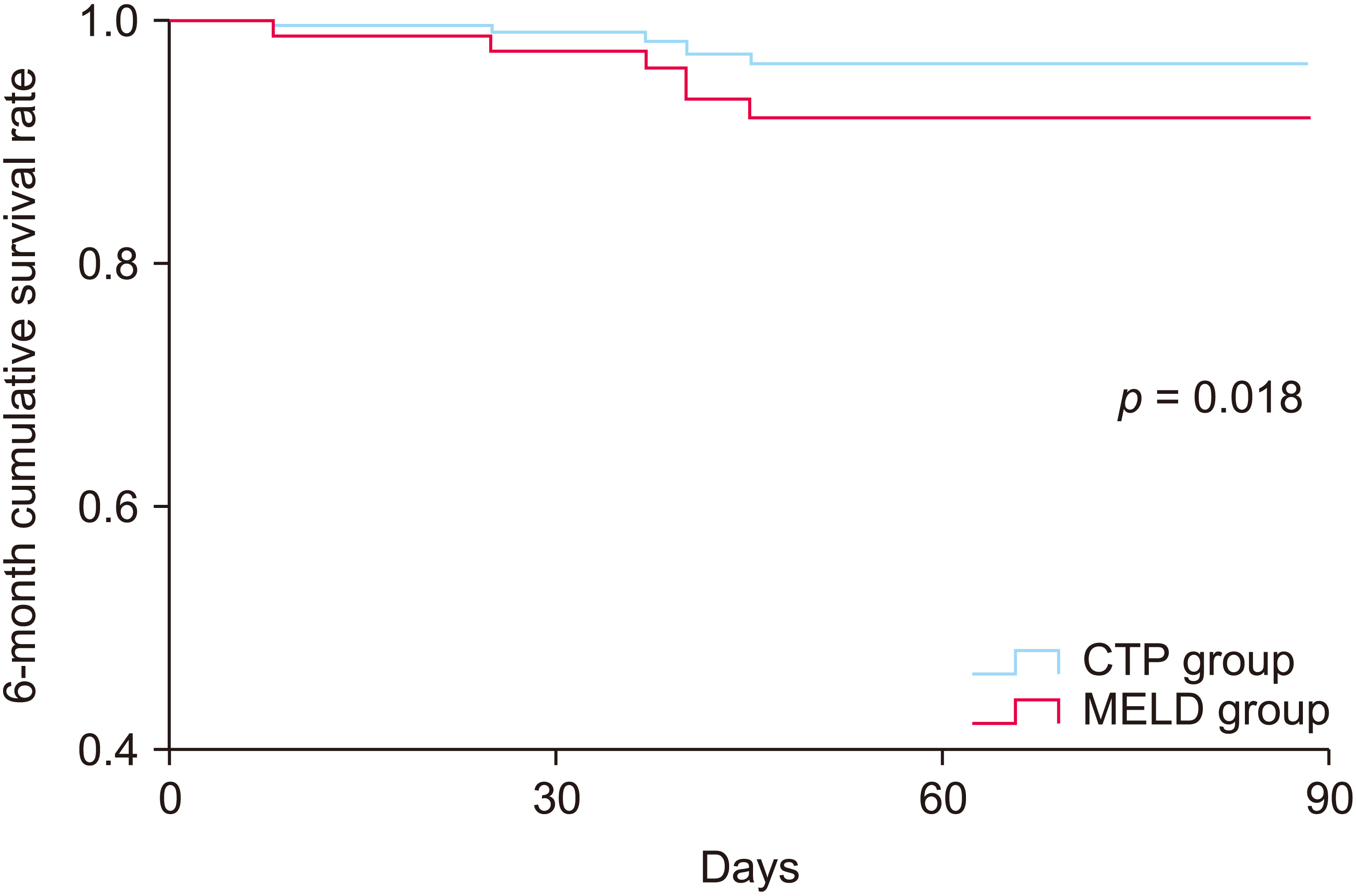Ann Hepatobiliary Pancreat Surg.
2021 Aug;25(3):336-341. 10.14701/ahbps.2021.25.3.336.
Impact of Model for End-Stage Liver Disease allocation system on outcomes of deceased donor liver transplantation: A single-center experience
- Affiliations
-
- 1Department of Surgery, Seoul National University College of Medicine, Seoul, Korea
- KMID: 2519289
- DOI: http://doi.org/10.14701/ahbps.2021.25.3.336
Abstract
- Backgrounds/Aims
From June of 2016, the Model for End-Stage Liver Disease (MELD)-based allocation system replaced the ChildTurcotte-Pugh (CTP) score-based system for organ allocation liver in Korea. The aim of this study was to analyze changes in outcomes and arising issues before and after the implementation of the MELD system.
Methods
From June 2014 to June 2018, 129 patients were selected from recipients who underwent deceased donor liver transplantation (DDLT) in Seoul National University Hospital. Pediatric cases were excluded. According to the allocation system, patients were divided into two groups (52 in the MELD group and 77 in the CTP group).
Results
MELD scores of the two groups differed significantly (37.8 ± 2.0 in the MELD group vs. 31.0 ± 8.2 in the CTP group; p = 0.001). The etiology of patients was changed for liver transplantation. The proportion of alcoholic liver cirrhosis increased in the era of the MELD allocation system. However, proportions of hepatitis B related liver cirrhosis and hepatocellular carcinoma were decreased. Six-month mortality rate of the MELD group was 25.0%, which was higher than that (11.7%) of the CTP group (p = 0.022). The 90-day complication rate was significantly higher in the MELD group than in the CTP group (11.5% vs. 2.6%; p = 0.040).
Conclusions
When the MELD allocation system was used to distribute livers to severely ill patients, it resulted in poorer outcomes after surgery and higher proportion of alcoholic cirrhosis. Thus, it is necessary to adjust the MELD allocation system so that outcomes after DDLT could be improved.
Figure
Cited by 1 articles
-
The impact of Model for End-Stage Liver Disease score on deceased donor liver transplant outcomes in low volume liver transplantation center: a retrospective and single-center study
Doo-Ho Lee, Yeon Ho Park, Seok Won Choi, Kug Hyun Nam, Sang Tae Choi, Doojin Kim
Ann Surg Treat Res. 2021;101(6):360-367. doi: 10.4174/astr.2021.101.6.360.
Reference
-
1. Bertsimas D, Kung J, Trichakis N, Wang Y, Hirose R, Vagefi PA. 2019; Development and validation of an optimized prediction of mortality for candidates awaiting liver transplantation. Am J Transplant. 19:1109–1118. DOI: 10.1111/ajt.15172. PMID: 30411495.
Article2. Lee J, Lee JG, Jung I, Joo DJ, Kim SI, Kim MS. 2019; Development of a Korean liver allocation system using model for end stage liver disease scores: a nationwide, multicenter study. Sci Rep. 9:7495. DOI: 10.1038/s41598-019-43965-2. PMID: 31097768. PMCID: PMC6522508.
Article3. Wiesner R, Edwards E, Freeman R, Harper A, Kim R, Kamath P, et al. 2003; Model for end-stage liver disease (MELD) and allocation of donor livers. Gastroenterology. 124:91–96. DOI: 10.1053/gast.2003.50016. PMID: 12512033.
Article4. Thompson MA, Redden DT, Glueckert L, Smith AB, Crawford JH, Jones KA, et al. 2014; Risk factors associated with reoperation for bleeding following liver transplantation. HPB Surg. 2014:816246. DOI: 10.1155/2014/816246. PMID: 25505820. PMCID: PMC4258335.
Article5. Massicotte L, Carrier FM, Karakiewicz P, Hevesi Z, Thibeault L, Nozza A, et al. 2019; Impact of MELD score-based organ allocation on mortality, bleeding, and transfusion in liver transplantation: a before-and-after observational cohort study. J Cardiothorac Vasc Anesth. 33:2719–2725. DOI: 10.1053/j.jvca.2019.03.008. PMID: 31072701.
Article6. Kamath PS, Kim WR. 2007; The model for end-stage liver disease (MELD). Hepatology. 45:797–805. DOI: 10.1002/hep.21563. PMID: 17326206.
Article7. Elwir S, Lake J. 2016; Current status of liver allocation in the United States. Gastroenterol Hepatol (N Y). 12:166–170. PMID: 27231445. PMCID: PMC4872844.8. Wedd JP, Harper AM, Biggins SW. 2013; MELD score, allocation, and distribution in the United States. Clin Liver Dis (Hoboken). 2:148–151. DOI: 10.1002/cld.233. PMID: 30992850. PMCID: PMC6448651.
Article9. Lee JA, Choi GS, Kim JM, Kwon CH, Joh JW. 2018; Comparison study of outcomes of deceased donor liver transplantation before and after Korean model for end-stage liver disease (MELD) system: single center experience. J Korean Soc Transplant. 32:7–11. DOI: 10.4285/jkstn.2018.32.1.7.
Article10. Croome KP, Lee DD, Burns JM, Keaveny AP, Taner CB. 2018; Intraregional model for end-stage liver disease score variation in liver transplantation: disparity in our own backyard. Liver Transpl. 24:488–496. DOI: 10.1002/lt.25021. PMID: 29365357.
Article11. Jurado-García J, Muñoz García-Borruel M, Rodríguez-Perálvarez ML, Ruíz-Cuesta P, Poyato-González A, Barrera-Baena P, et al. 2016; Impact of MELD allocation system on waiting list and early post-liver transplant mortality. PLoS One. 11:e0155822. DOI: 10.1371/journal.pone.0155822. PMID: 27299728. PMCID: PMC4907519.
Article12. Lau L, Kankanige Y, Rubinstein B, Jones R, Christophi C, Muralidharan V, et al. 2017; Machine-learning algorithms predict graft failure after liver transplantation. Transplantation. 101:e125–e132. DOI: 10.1097/TP.0000000000001600. PMID: 27941428. PMCID: PMC7228574.
Article13. Marroni CA, Fleck AM Jr, Fernandes SA, Galant LH, Mucenic M, de Mattos Meine MH, et al. 2018; Liver transplantation and alcoholic liver disease: history, controversies, and considerations. World J Gastroenterol. 24:2785–2805. DOI: 10.3748/wjg.v24.i26.2785. PMID: 30018475. PMCID: PMC6048431.
Article14. López-Navas A, Ríos A, Riquelme A, Martínez-Alarcón L, Pons JA, Miras M, et al. 2011; Psychological care: social and family support for patients awaiting a liver transplant. Transplant Proc. 43:701–704. DOI: 10.1016/j.transproceed.2011.01.095. PMID: 21486578.
Article
- Full Text Links
- Actions
-
Cited
- CITED
-
- Close
- Share
- Similar articles
-
- Current Status of Deceased Donor Liver Transplantation for Alcoholic Liver Disease in Korea in MELD Era
- Comparison Study of Outcomes of Deceased Donor Liver Transplantation before and after Korean Model for End-Stage Liver Disease (MELD) System: Single Center Experience
- Impact of MELD allocation system on the outcomes of deceased donor liver transplantation: a single-center experience
- The impact of Model for End-Stage Liver Disease score on deceased donor liver transplant outcomes in low volume liver transplantation center: a retrospective and singlecenter study
- Outcome of patients with severe alcoholic hepatitis after Model for End-Stage Liver Disease-based allocation system implementation in Korea




